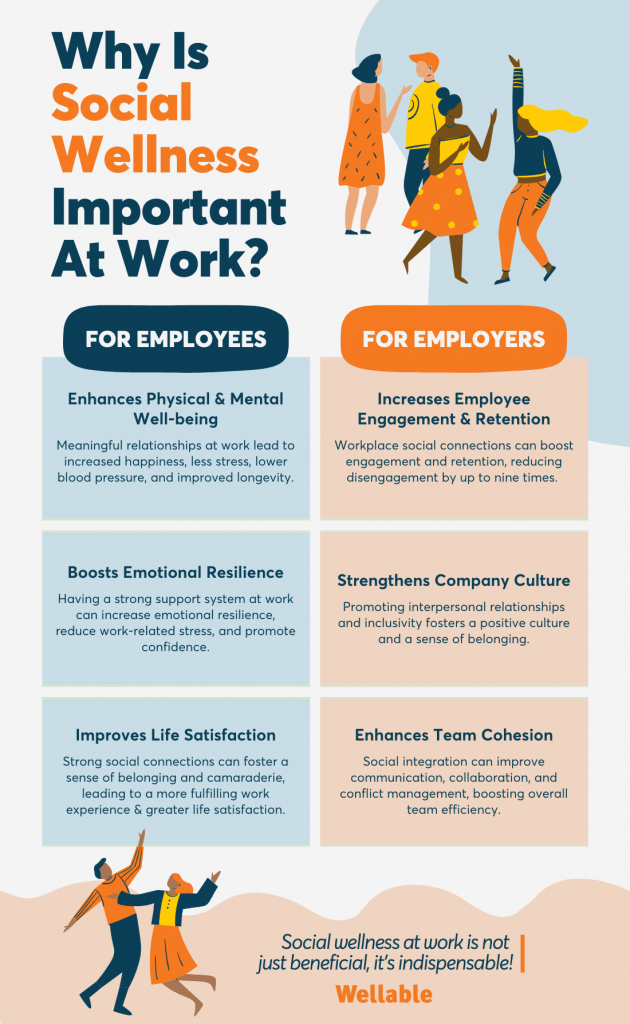Maintaining employee physical and mental health undoubtedly plays a critical role in creating a thriving workplace. Yet, an equally vital facet of well-being is often overlooked: social wellness. The power of meaningful workplace connections and strong support systems extends beyond enhancing job satisfaction. It fuels communication and collaboration that catalyze organizational success.
This comprehensive article covers the definition of social wellness, highlights its importance, and offers actionable strategies to cultivate and measure social well-being in the workplace.
Pressed for time? Here’s a quick summary…
- Social wellness refers to the state of fostering connections, cultivating a strong support system, and engaging in trustworthy, respectful, and authentic relationships.
- Social wellness enhances employee well-being, emotional resilience, and life satisfaction while simultaneously boosting employee engagement and retention, which elevates both company culture and work efficiency.
- Employers can support employee social well-being by providing regular recognition, offering team-building activities, involving leadership, practicing open communication, and establishing a culture of care.
- Employees can support their own social well-being by increasing their emotional intelligence, setting boundaries, offering and asking for support, showing appreciation, and making time for relationship-building.
- Key metrics such as wellness program participation, communication frequency and effectiveness, employee satisfaction, employee turnover rates, and changes in absenteeism can offer employers insight into the state of their employees’ well-being.
What Is Social Wellness?

Social wellness refers to the state of fostering connections, cultivating a strong support system, and engaging in trustworthy, respectful, and authentic relationships.
As a social species, human holistic well-being depends on a sense of belonging. In the workplace, an employee’s social wellness can be nurtured through positive interactions with team members that amplify a shared sense of unity amongst team members.
Key components of social wellness include:
- Cultivating assertiveness and self-confidence;
- Striking a healthy balance between social engagement and solidarity;
- Embracing authenticity in every interaction;
- Participating actively in community connections;
- Valuing diversity and treating others with respect;
- Increasing awareness of one’s responsibilities for the welfare of the greater community;
- Creating and sustaining meaningful friendships and social networks;
- Establishing relationship boundaries that foster open communication, trust, and effective conflict resolution;
- Embracing enjoyment and leisure as essential aspects of life; and,
- Building a reliable support network.
Loneliness and social isolation can be as damaging to one’s health as smoking 15 cigarettes a day.
Why Is Social Wellness Important In The Workplace?
In the quest for a thriving and harmonious work environment, social wellness proves to be indispensable. This integral aspect of well-being has notable implications for both employees and employers.

For Employees
- Enhanced Physical & Mental Well-Being: Loneliness and social isolation can be as damaging to one’s health as smoking 15 cigarettes a day. Meaningful relationships are essential for physical and mental health, contributing to increased happiness, reduced stress levels, lowered blood pressure, and improved longevity.
- Heightened Emotional Resilience: Employees with a strong support system at work may have heightened emotional resilience. They often feel comfortable when seeking help for work-related challenges and confident when setting boundaries, helping mitigate work-related stress before it escalates.
- Greater Life Satisfaction: Nurturing social connections in the workplace fosters a sense of belonging and camaraderie. This can lead to not only a more fulfilling work experience but also greater life and job satisfaction.
For Employers
- Boosts Employee Engagement & Retention: Fostering social connections in the workplace can impact employee engagement and retention. Employees who lack meaningful connections at work are up to nine times more likely to be disengaged and three times more likely to actively seek a new job.
- Enhances Company Culture: Promoting strong interpersonal relationships and building an inclusive work environment creates a positive company culture in which employees feel a sense of belonging and connection.
- Improves Team Cohesion: Social integration results in better communication, collaboration, and conflict management, increasing overall efficiency.
Ways To Support Social Well-Being At Work

How Employers Can Support Employee Social Well-Being
Employers set the tone for a work environment that promotes and supports social wellness. They can employ several strategies to help employees cultivate authentic workplace relationships.
Recognition

Social well-being is magnified when employees feel appreciated for their contributions. Strategic recognition increases employee engagement, boosts perceptions of organizational care, and contributes to overall well-being.
- Sixty-nine percent of employees report that they would work harder if they felt more appreciated at work.
- Employees who believe that recognition is an important part of their company culture are up to 91% more likely to thrive.
- Employees who receive adequate recognition are 20% to 40% less likely to feel high levels of stress, worry, or sadness.
Recognition goes beyond simply acknowledging notable achievements; it can also be practiced by
- thanking a team member for having a positive attitude,
- acknowledging their work ethic, or
- identifying ways they have improved.
When employees feel valued as integral members of the organization at large, their sense of belonging and connection deepens.
Team-Building Activities
Team-building activities are instrumental in breaking down barriers and cultivating personal connections, which ultimately enhance the group dynamic. However, purposeless “mandatory fun” can elicit groans and eye rolls from even the most enthusiastic team players.

To encourage authentic bonding, team-building activities should be optional, yet purposeful. Whether that’s building trust, enhancing collaboration skills, or providing a casual opportunity for employees to get to know each other beyond their work roles, each activity should hold a clear, meaningful objective.
Leadership Involvement

Leaders can greatly influence social wellness by actively participating in team activities and wellness challenges, establishing a culture that values and reinforces social well-being. Whether they hold a senior executive position or serve as mid-level or front-line managers, leaders at every level should model a commitment to social wellness.
In most cases, mid-level and front-line leaders may have more interaction with employees than senior leaders. Promoting social well-being could be as simple as incorporating personal conversations into regular check-ins with employees while respecting personal boundaries.
Open Communication Channels
Relationships prosper when employees feel comfortable expressing their thoughts, ideas, and concerns. Transparent and frequent communication not only encourages collaboration and teamwork but also promotes trust and mutual understanding. By actively listening and providing opportunities for feedback, organizations empower employees to share their voices, fostering a sense of belonging and strengthening social connections.
Culture Of Care
The perception of a caring company culture varies across generations:
- Boomers (1946-1964) seek positions with a social purpose and robust wellness programs.
- GenX (1965-1978) prioritizes fostering friendships and achieving work-life balance.
- Millennials (1979-1996) value wellness programs, positive work environments, career autonomy, recognition, and socializing opportunities.
Given these generational gaps, encouraging feedback on desired social interactions and community outreach can help align employee preferences with efforts to enhance social well-being.
How Employees Can Support Their Own Social Well-Being
Employees play a primary role in supporting their own social well-being at work. By being intentional, they can foster positive connections, contributing to their overall health and happiness.
Emotional Intelligence

Building emotional intelligence can help employees develop and sustain healthy relationships at work and beyond. Components of emotional intelligence include:
- Self-Awareness: Understanding one’s career and relationship needs, strengths, and weaknesses.
- Self-Regulation: Managing one’s emotions and thoughts despite external circumstances.
- Empathy: Comprehending and connecting with someone else’s situation.
- Social Skills: Teamwork, conflict resolution, communication, and problem-solving are vital social skills for building relationships.
Boundaries
Setting good boundaries is a learned skill that improves productivity and, more importantly, is a form of self-care. By setting clear boundaries, employees create a shared understanding of acceptable behavior and establish realistic work expectations. Being both assertive and respectful when voicing boundaries prevents conflict and misunderstandings, leading to satisfaction for both parties.
Consider these examples of healthy boundary-setting:
- An employee wants to decline an invitation to a happy hour event.
Employee: I wanted to let you know that I won’t be able to join happy hour. I have personal commitments that I need to attend to.
Colleague: That’s totally understandable. We’ll miss you but take care of what you need to do!
- An employee has a full workload and cannot take on additional tasks.
Employee: I appreciate you considering me for this task, but my workload is already quite full. I want to ensure that I can give my best to the current projects.
Manager: Thank you for letting me know. I understand the importance of managing your workload effectively. Let’s discuss how we can prioritize tasks or explore other options to support you.
- An employee is uncomfortable with the way they are being spoken to.
Employee: I would like to discuss the way we communicate with each other. I believe it’s important to maintain a respectful and constructive tone during our interactions.
Colleague: I apologize if my tone came across as disrespectful. That was not my intention. How can we work together to ensure our communication remains positive and productive?
Mutual Support
Relationships thrive on reciprocity. Lending a helping hand to an overwhelmed co-worker establishes trust and support. Likewise, employees shouldn’t hesitate to ask for assistance when needed, as it opens the door to workplace connections and collaboration.
Appreciation
Recognize that each employee has unique goals and challenges and reframe potential frustrations with understanding. Instead of assigning blame or making assumptions, focus on collaborative problem-solving. By working together productively and professionally, employees can develop an appreciation for their co-workers and build a positive foundation for relationships to flourish.
Scheduling

Strong relationships are built over time. Amid daily responsibilities and job demands, finding time to interact with colleagues can be challenging. Consider starting meetings with casual check-ins or setting aside time outside of work hours for more personal conversations, like grabbing a coffee before the workday. Scheduling dedicated moments for relationship-building fosters stronger connections with team members.
10 Activities For Social Wellness
Creating opportunities for employees to connect and collaborate is key to fostering social wellness in the workplace. Here are ten engaging ideas to help teams strengthen relationships and grow together:
- Volunteer Days
Bring the team together through meaningful volunteer events that give back to the community. Activities like cleaning up local parks, serving at food banks, or assisting in charity events cultivate a sense of shared purpose and accomplishment.
- Sports Clubs And Fitness Challenges
Create company intramural sports teams or host fitness challenges to spark friendly competition and foster camaraderie. Whether it’s lunchtime basketball games or quarterly step challenges, these activities promote teamwork and build healthy habits.

- Potlucks
Organize a potluck as a fun and delicious way to connect employees informally. Encourage team members to showcase their cultural backgrounds through dishes or add a healthy twist by sharing nutritious versions of their favorite comfort foods.
- Book Clubs
Launch a quarterly or bi-monthly book club where employees can recommend and discuss their favorite books, from inspiring professional development reads to escapist fiction. These gatherings create an inviting space for connecting intellectually, sharing interests, and glimpsing into colleagues’ passions.

- Company Retreats
Take team building to the next level with an off-site company retreat. This could be a ski trip, beach getaway, or yoga and wellness excursion—anything that allows employees to spend extended time with each other outside of the office for deepened bonds.
- Mentorship Programs
Pair employees with mentors across departments or experience levels to inspire growth and encourage connection. These programs support professional development, create meaningful relationships, and build a stronger sense of community within the organization.

- Coffee Chats
Encourage casual one-on-one coffee chats between colleagues. These informal breaks help employees build rapport and better understand each other’s roles.
- Themed Happy Hour
Uplevel traditional happy hours by selecting a creative theme like “Around the World,” “80’s Disco Party,” or “Red Carpet.” Encourage team members to bring related cocktails or mocktails, adding a playful touch to after-work socializing.

- Lunch And Learns
Make lunch breaks fun and productive with “lunch and learn” sessions. Employees can volunteer to share a skill they’ve developed (e.g., speaking a new language, mastering crocheting, sharing industry insights) with the team.
- Creative Workshops
Host hands-on creative activities like painting, cooking, or crafting classes. These workshops offer a break from routine, nurture artistic expression, and create shared memories among co-workers.
How To Measure Social Well-Being At Work
High-quality social relationships are crucial for happiness and overall well-being. However, assessing one’s level of social wellness can be challenging due to its subjective nature. The European Social Survey (ESS) Wellbeing Module provides a self-measurement tool to evaluate social well-being, focusing on:
- Feelings: Belonging, social progress, social support, and social recognition
- Functioning: Altruism, engagement, and care
- Social Functioning: Level of satisfaction with relationships
- Social Support: Level of trust in others
In the workplace, key indicators can offer insights into the state of employees’ social and overall well-being:
- Wellness Program Participation: How has engagement in wellness programs influenced employees’ sense of social connection and overall well-being?
- Communication: How have improvements or declines in communication practices impacted employees’ ability to build and maintain strong social relationships and manage conflict in the workplace?
- Employee Satisfaction: To what extent does employee satisfaction reflect the level of social support and connectedness experienced within the organization?
- Employee Turnover Rates: How do turnover rates correlate with the level of social well-being among employees? Are there any notable patterns or trends?
- Changes In Absenteeism: What connections can be drawn between the level of social wellness and fluctuations in absenteeism rates? How does social support impact employees’ attendance and engagement in the workplace?
This article was last updated on December 23, 2024












